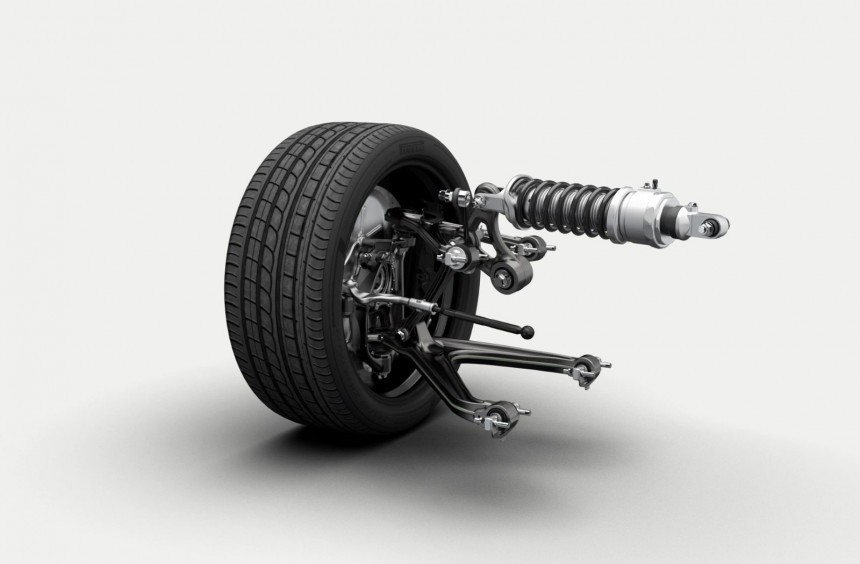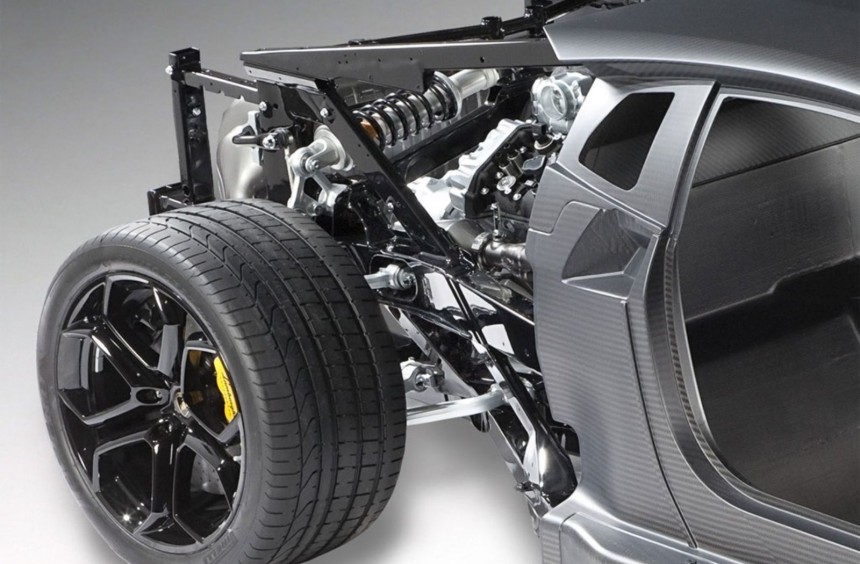A decade after its debut, the Aventador will be riding into the sunset this year with the Ultimae as its final iteration. As we’re getting ready to say goodbye to this amazing vehicle, let’s take a look at one of its most innovative features, the motorsport-inspired pushrod suspension system.
The Aventador made its public debut in February 2011 at the Geneva Motor Show, several months after its initial unveiling back home in Italy. This early version of the manufacturer’s newest V12 flagship was codenamed LP700-4 and apart from a completely new twelve-cylinder, it was the first production Lamborghini to employ a fully independent, pushrod-actuated suspension.
Pioneered on race cars, mainly open-wheelers and prototypes, this configuration allows engineers to move suspension components closer to the ground which lowers the car’s center of gravity, improves weight distribution, and ultimately results in improved handling, especially at higher speeds.
However, this layout was rarely used on road-legal vehicles because although it proved to be excellent on track, it sacrificed ride comfort on public roads.
The folks at Lamborghini worked hard on their bespoke design so that it could provide as much comfort as possible in day-to-day driving scenarios but also retain its superior track capabilities.
In the front, as soon as you take the wheel off, you’ll be greeted by a beautifully sculptured double-wishbone setup with all components made from high-strength yet lightweight forged aluminum.
The all-important dog bone-shaped pushrod is linked to a triangular bellcrank that hinges to a fixed point on the chassis and on the upper end, it bolts directly to the horizontally placed shock absorber.
Moving on to the rear, we find a similar arrangement albeit with a lower wishbone biased toward the front. The anterior half has a more effective longitudinal load path while the posterior half provides a dedicated lateral load.
The way this setup works is pretty simple: the lower arm connected to the wheel drives the pushrod upwards, lifting the bellcrank and engaging the near-horizontally fitted spring and shock assembly.
Apart from its inherent advantages and the obvious reduction in weight achieved by using lightweight materials, this configuration frees up space which makes room for wider wheels and tires for even more stability. The Aventador LP700-4 rides on 19-inch forged alloys with 225/35 Pirelli P Zeros in the front and 20-inch variants with massive 335/30 tires in the back.
Okay, so how did the engineers manage to make this system effective on multiple road surfaces? Well, the short answer would be that they didn’t. Even though the suspension has been refined with every new iteration, the Aventador is not a car that can be driven on a pothole-ridden backroad, and even crossing a regular speed bump can be a spine-damaging experience if you don’t adjust your speed properly.
Nevertheless, the magnetorheological shocks and springs have been specifically designed to offer more travel, adapt to various road conditions, and deliver more comfort than those fitted onto a Formula One racer or Le Mans prototype. Because of that, the experience of driving one of these outstanding vehicles through the city cannot be described as a nightmare. The suspension does an adequate job of filtering out road imperfections, as long as they aren’t too pronounced.
The superiority of the pushrod system can be felt on highways or the racetrack, especially at higher speeds. In these scenarios, you begin to feel like you’re driving a racecar and the astonishing grip coupled with minimal body roll provided by this setup will make you forget about its limitations. After all, this is one of the most spectacular supercars of the last decade and it was never meant to be a daily driver.
While not perfect, this suspension system is unquestionably one of the hypercar’s most innovative features. It is a milestone for Lamborghini and makes the Aventador - particularly in SVJ guise – the best-handling flagship in company history.
Pioneered on race cars, mainly open-wheelers and prototypes, this configuration allows engineers to move suspension components closer to the ground which lowers the car’s center of gravity, improves weight distribution, and ultimately results in improved handling, especially at higher speeds.
However, this layout was rarely used on road-legal vehicles because although it proved to be excellent on track, it sacrificed ride comfort on public roads.
The folks at Lamborghini worked hard on their bespoke design so that it could provide as much comfort as possible in day-to-day driving scenarios but also retain its superior track capabilities.
The all-important dog bone-shaped pushrod is linked to a triangular bellcrank that hinges to a fixed point on the chassis and on the upper end, it bolts directly to the horizontally placed shock absorber.
Moving on to the rear, we find a similar arrangement albeit with a lower wishbone biased toward the front. The anterior half has a more effective longitudinal load path while the posterior half provides a dedicated lateral load.
Apart from its inherent advantages and the obvious reduction in weight achieved by using lightweight materials, this configuration frees up space which makes room for wider wheels and tires for even more stability. The Aventador LP700-4 rides on 19-inch forged alloys with 225/35 Pirelli P Zeros in the front and 20-inch variants with massive 335/30 tires in the back.
Okay, so how did the engineers manage to make this system effective on multiple road surfaces? Well, the short answer would be that they didn’t. Even though the suspension has been refined with every new iteration, the Aventador is not a car that can be driven on a pothole-ridden backroad, and even crossing a regular speed bump can be a spine-damaging experience if you don’t adjust your speed properly.
The superiority of the pushrod system can be felt on highways or the racetrack, especially at higher speeds. In these scenarios, you begin to feel like you’re driving a racecar and the astonishing grip coupled with minimal body roll provided by this setup will make you forget about its limitations. After all, this is one of the most spectacular supercars of the last decade and it was never meant to be a daily driver.
While not perfect, this suspension system is unquestionably one of the hypercar’s most innovative features. It is a milestone for Lamborghini and makes the Aventador - particularly in SVJ guise – the best-handling flagship in company history.


















